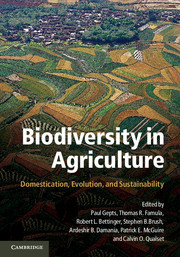Book contents
- Frontmatter
- Contents
- Tables
- Figures
- Foreword
- Contributors
- Acknowledgments
- Introduction: The Domestication of Plants and Animals: Ten Unanswered Questions
- 1 The Local Origins of Domestication
- Section I Early Steps in Agricultural Domestication
- Section II Domestication of Animals and Impacts on Humans
- Section III Issues in Plant Domestication
- Section IV Traditional Management of Biodiversity
- 17 Ecological Approaches to Crop Domestication
- 18 Agrobiodiversity Shifts on Three Continents Since Vavilov and Harlan: Assessing Causes, Processes, and Implications for Food Security
- 19 Indigenous Peoples Conserving, Managing, and Creating Biodiversity
- 20 Land Architecture in the Maya Lowlands: Implications for Sustainability
- 21 Agrobiodiversity and Water Resources in Agricultural Landscape Evolution (Andean Valley Irrigation, Bolivia, 1986 to 2008)
- Section V Uses of Biodiversity and New and Future Domestications
- Index
- References
17 - Ecological Approaches to Crop Domestication
Published online by Cambridge University Press: 05 June 2012
- Frontmatter
- Contents
- Tables
- Figures
- Foreword
- Contributors
- Acknowledgments
- Introduction: The Domestication of Plants and Animals: Ten Unanswered Questions
- 1 The Local Origins of Domestication
- Section I Early Steps in Agricultural Domestication
- Section II Domestication of Animals and Impacts on Humans
- Section III Issues in Plant Domestication
- Section IV Traditional Management of Biodiversity
- 17 Ecological Approaches to Crop Domestication
- 18 Agrobiodiversity Shifts on Three Continents Since Vavilov and Harlan: Assessing Causes, Processes, and Implications for Food Security
- 19 Indigenous Peoples Conserving, Managing, and Creating Biodiversity
- 20 Land Architecture in the Maya Lowlands: Implications for Sustainability
- 21 Agrobiodiversity and Water Resources in Agricultural Landscape Evolution (Andean Valley Irrigation, Bolivia, 1986 to 2008)
- Section V Uses of Biodiversity and New and Future Domestications
- Index
- References
Summary
Understanding evolutionary adaptation of crop plants requires understanding the ecology of their wild ancestors and the selective pressures that cultivators exerted when they began manipulating plants and shaping agricultural environments. For most plants, especially the diverse clonally propagated crops, we have only a broad-brush picture of the evolutionary ecology of domestication. Detailed investigations of crop wild relatives are rare, as are studies that take into account the full complexity of cultivated environments, from altered ecosystem processes and selective mechanisms to biotic interactions of crop plants with parasites and mutualists. The most important mutualists are the cultivators themselves, and an important part of the biotic environment of crop plants – what happens inside farmers' heads – has sometimes been neglected. Ecology – the interactions among cultivators, plants, and environments – has shaped the process of domestication. It continues to provide insights into ongoing processes of domestication today, in settings as diverse as landrace populations and biotechnology laboratories, and can inform strategies for managing the biodiversity of crop plants and their wild relatives.
In this chapter, we develop major themes in the evolutionary ecology of domestication. We show that evolution under domestication can contribute important insights into general questions in evolutionary ecology. We argue that much is to be gained from a broadening of domestication studies beyond their current focus on evolution in cereals and grain legumes, to encompass the great diversity of plants that cultivators have manipulated over the past 10,000 years, in what is the world's longest-running selection experiment (Gepts 2004).
- Type
- Chapter
- Information
- Biodiversity in AgricultureDomestication, Evolution, and Sustainability, pp. 377 - 406Publisher: Cambridge University PressPrint publication year: 2012
References
- 31
- Cited by



